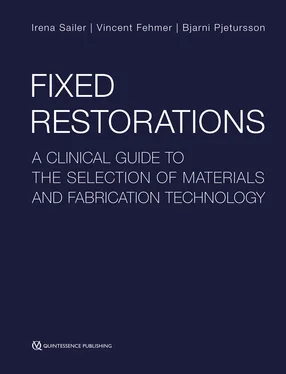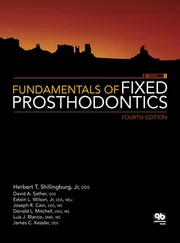It is important to understand the fracture mechanisms of the different materials. In metals the crack tip is rounded out by plastic flow and thus the risk of fracture is significantly reduced (Fig 1-1-1). In ceramics plastic flow is not possible due to the covalent bonds. The crack tip remains sharp and crack growth is a significantly higher risk than in metals. That is the reason for the well-known brittle behavior of ceramics. To increase strength and in particular toughness, strengthening mechanisms on the microscopic level to impede crack propagation are employed. In brittle materials this might be achieved by internal compression or by particles, which act as obstacles against crack growth (Fig 1-1-2). The objective of such strengthening mechanisms is to stop crack growth or at least to hamper it, like a hurdler who is not as fast as a sprinter.
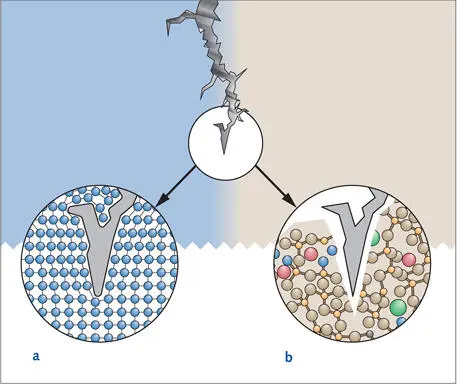
Figs 1-1-1 Schematic representation of crack propagation in materials. (a)Plastic material (eg, metals). (b)Brittle material (eg, ceramics).

Fig 1-1-2 Schematic representation of crack propagation in particle-reinforced materials under tensile stress (red arrows). When the crack tip strikes a particle, crack propagation is impeded, or at least decelerated.
The term durability includes not only the mechanical characteristics specified above but resistance to wear and aging as well. The degradation of the materials by wear and aging depends on the mechanical properties and also on the susceptibility to the oral environment including humidity, temperature, and loading characteristics. Water for instance may attack the material’s bonds especially at phase boundaries or microcracks, thus promoting degradation.
Design
Several mistakes can be made when designing a restoration. Insufficient dimensioning in crown walls or connectors of fixed dental prostheses is one reason for failures. Instructions of the manufacturers have to be strictly followed. Further, sharp edges increase the risk of failure due to an uncontrolled stress development (Fig 1-1-3). And finally, restorations made by materials, which require a thermal treatment should be designed with an even wall thickness as far as possible to get a homogeneous stress distribution during cooling. That applies especially for veneering ceramics, which must be layered in a uniform thickness and adequately supported by the framework both for metal-ceramic and all-ceramic bilayers.
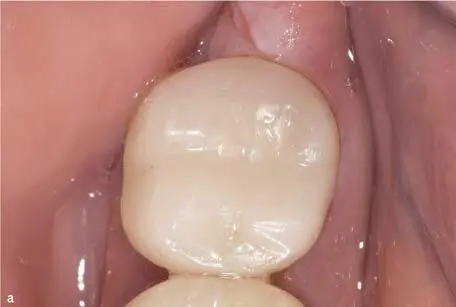
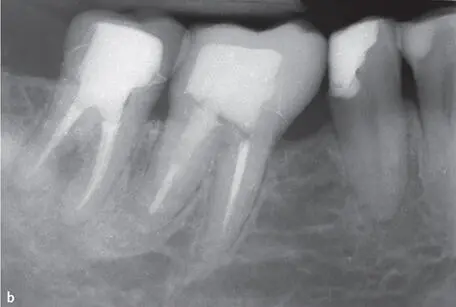

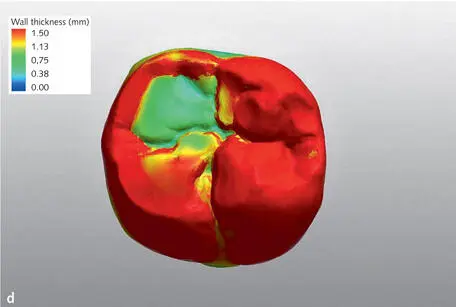
Figs 1-1-3a to 1-1-3d Insufficient thickness of the crown and sharp edges of the preparation caused fracture of the restoration. (a)Restoration on tooth 47 after cementation. (b)Radiograph after cementation. The insufficient occlusal thickness of the restoration and the sharp edge of the distal preparation are obvious. (c)Fracture of the restoration after 1 year in function. (d)Analysis of wall thickness on the basis of the CAD design.
Processing
A shaping process always requires machining, a thermal treatment such as sintering or pressing or a polymerization process. If not processed properly, defects might be created in the material, thus reducing the strength of the restoration (Fig 1-1-4). The manufacturer’s instructions must be meticulously followed.
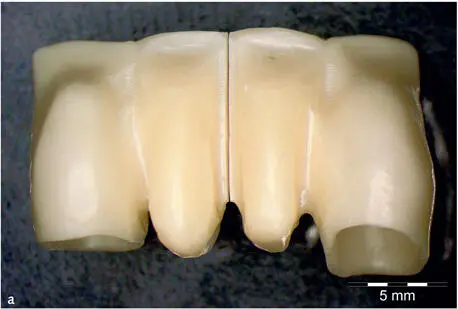
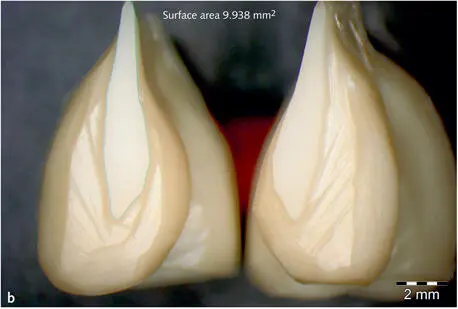
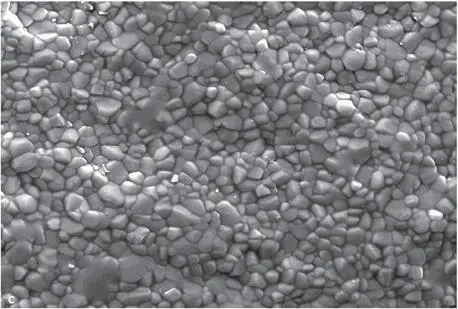
Figs 1-1-4a to 1-1-4c Fractured zirconia framework 42 x x 32. (a)Framework after sintering, fracture occurred between 41 and 31. (b)Light microscopy image of the fractured area. The area was cut in the white state in order to separate the two pontics. Thus a crack was initiated, which was not sealed during sintering. (c)Scanning electron microscopy (SEM) of the fractured surface after sintering. The formation of grains at the surface indicates that the fracture occurred before sintering.
Finishing
Materials, if machined, sintered, pressed, or polymerized, must be finished with material specific tools and appropriate speed, feed, and pressure of the tools to avoid damage at the surface. For ceramics, as an alternative a glaze firing (a heat treatment without additional application of glaze) or glazing (a heat treatment with additional application of glaze) can be performed (Fig 1-1-5). However, if the restoration is not handled in a way appropriate to the material, it might occur that subsurface damage is not sufficiently eliminated by the finishing procedure and residual flaws potentially act as an origin for microcracks.




Figs 1-1-5a to 1-1-5d Schematic representation of the effect of polishing, glaze firing, or glazing on the surface quality. (a)Microcracks at the surface after processing. (b)Surface after polishing. (c)Surface after glaze firing. (d)Surface after glazing.
Esthetics
Materials for restoring teeth have to mimic the esthetic appearance of the tooth itself. The tooth is a complex structure of a dentin core, providing the color of the tooth, and a more translucent enamel layer. The replacement of dental hard tissue by a dental material needs to balance color, translucency, refraction and reflection, opalescence, and fluorescence . Some materials show a blending quality , also named the “chameleon effect.” These requirements strongly restrict the choice of materials to ceramics and resins. As a compromise metals may be used when covered by tooth-colored veneers.
Читать дальше
